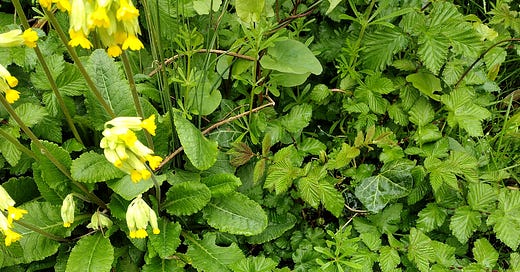
Dear art, flower and nature friend,
How are you? It’s been very hot around here recently, although we have had some rain overnight. How has it been where you are? So, about the heat - it seems to me there have always been certain years we’ve referenced in terms of heat waves (1976, anyone? 1995?) but in recent years, the summer heat has been pretty consistent, unusual for the UK North West, and now I’m also reading about La Niña / El Niño events. It’s pretty overwhelming to me so I choose to follow my tried and tested path of focussing on all the plants growing around me. Lately, this has led to thoughts about plant blindness - I have some friends I walk regularly with and I’m often struck by how different our relationships with plants are. Some express surprise “that the weeds are so pretty” , others don’t seem to see any plants at all! I want to encourage a connection to nature, a ‘buy-in’ if you will, so I’m always trying to get people into plant spotting, but it’s hard when they suffer from plant blindness!
So … let’s talk about green, my favourite colour (mostly). Lately I’ve been reading Dr Qing Li’s excellent book ‘Into the Forest’ which extolls the virtues of forest bathing. Li talks about the importance of the colour green to human health and survival, pointing out that historically, recognition of patterns in the sea of green would be a skill essential to our survival. Recognising plants by their colour, leaf shapes, size and buds meant knowing which plants were in season and safe to eat. Yet the inability to distinguish different plants in the green vista is now so prevalent that in 1998 US botanists and biology educators Elisabeth Schussler and James Wandersee coined the term “plant blindness”.
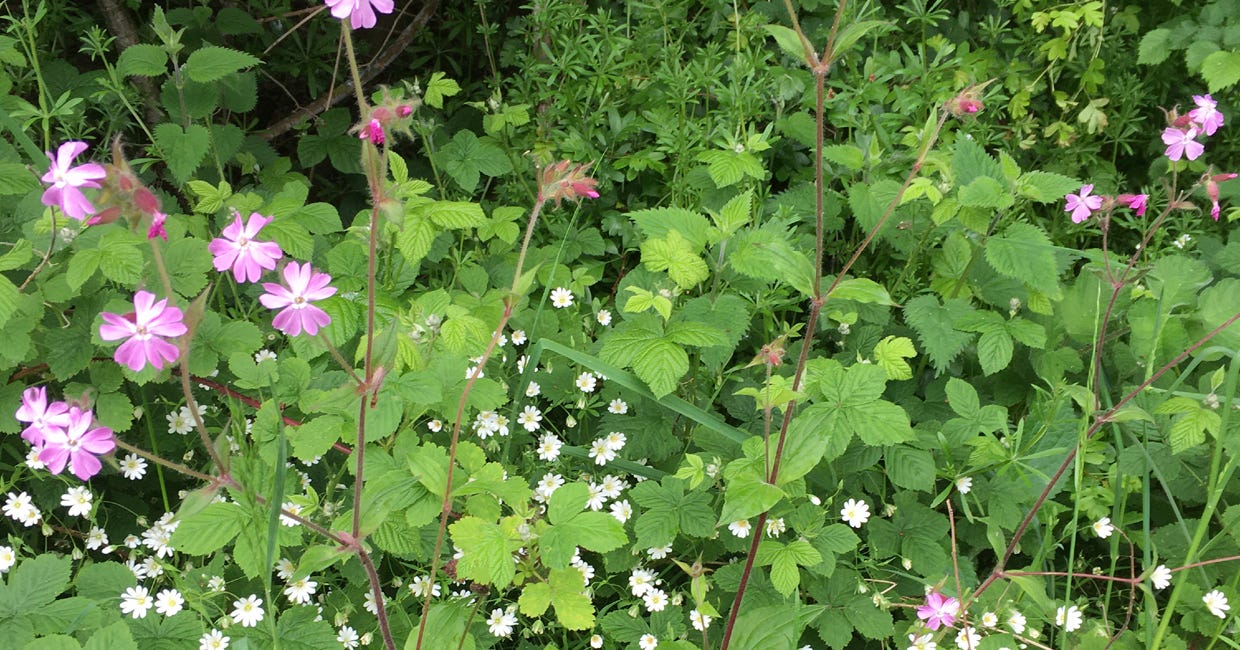
I wonder what you see in this image? You’re reading this, indicating an interest in plants and nature, so I imagine you see more than some. It’s a small patch of ground, perhaps two square foot, on the edge of a small wood I visit regularly. Scanning it quickly I see about eight different plants (red campion, stitchwort, goosegrass, bramble, nettle, hawthorn, sweet vernal grass, birch - there may be more). Always looking to see what’s around and a month ago, walking my regular path, I noticed a stand of cow parsley which just didn’t seem to be flowering. I then missed a few walks (b/c Covid!) and on my return, realised it was actually hemlock - the young leaves looked pretty similar (albeit larger). Now I’m noticing hemlock everywhere - and I’m bothered by the fact it looks so similar to cow parsley, at least superficially. Cow parsley is harmless - hemlock is extremely poisonous. It’s the plant used to kill Socrates so knowing the difference is pretty important, especially if you are the friend who thinks weeds are really pretty!

Above, some cow parsley, there it is, bottom left, one plant in, between the nettles and the hogweed. Cow parsley grows to a height of roughly one metre and has a green stem with vertical ridges. It’s an umbellifer with large flowerheads comprising many small florets in separate umbels. So is hemlock - but it grows to 2.5 metres, and the stem is smooth, with a pale, almost lime green base, and dark red-purple blotches, like mottled bruising. It’s useful to know that hemlock smells bad, like sweaty socks. Avoid!
My phone is full of pictures like these. As an artist specialising in plants I’m always inspired by the many textures, different shades of green, interesting leaves, often in very small patches of land. And so, back to Dr Qing Li, the world’s foremost expert in Forest Medicine who started researching the many ways in which forests are beneficial to human health back in 2004. His work illuminates not only the positive impacts of forest time on mental health but the demonstrable benefits of trees on physical health, particularly supporting and even strengthening our immune systems.
Forest bathing is about engaging with nature using all your senses - taking your shoes and socks off to feel and connect with the earth, breathing in the scent of the trees and the soil, smelling the freshness of the air, listening to the sounds - wind in the leaves, birdsong. His research has also proven the benefits of proximity to nature in healing - if a hospital window has a tree outside it, it promotes recovery. Although clearly, being in amongst the trees is the ultimate goal, he even explains how just looking at pictures or watching nature documentaries can help - a great way to start working on plant blindness! I talk a lot about connecting with nature, and I love being outdoors, but if you can’t so easily access a green space, it’s comforting to know you can always watch Green Planet for a dose of forest medicine. I do this regularly and I genuinely believe it helps - that and reading inspiring books like ‘Into the Forest’. Here’s a plea from me - please tell me about your favourite nature books! I’d like to put together a reading list (I’ll happily share it) and I’d love to know what yours are?
Of course, paper botany and art need a mention too. Looking closely at nature and attempting to recreate what I see is my daily medicine. Here’s a glimpse at a few recent makes, all created using 180g Italian crepe paper, coloured with natural dyes and stains:

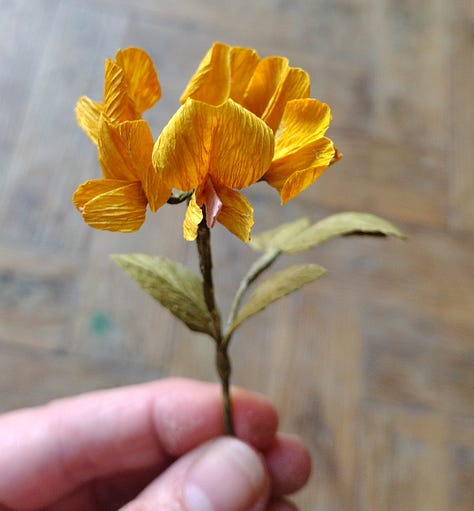
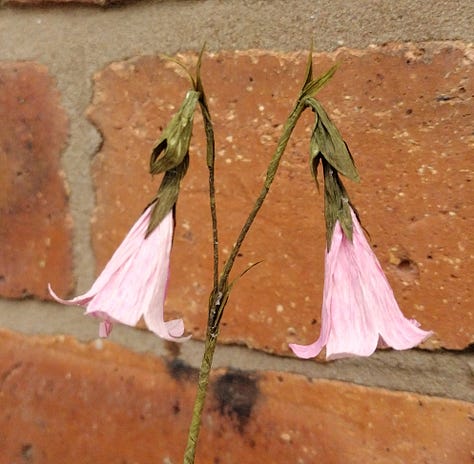
I’m always fascinated by grasses - not always thought of as a flowering plant although of course they are. Seeing the shape of the false oat grass flower heads up close (I use magnifying binoculars or a lupe) put me in mind of the Bird of Paradise flower. I do think there is some scant relationship as they are both monocots in the same clade (yes, I’ve been at Wikipedia again!). In the middle is Birdsfoot Trefoil (also known as Eggs and Bacon) - a flower I’m currently proto-typing for Nature’s Palette 2.0 (henceforth to be known as “Paper Hedgerow”) - I’ve refined it some more since this pic but I do love the deep, rich colour of the petals here, coloured with brown onion skin. Finally, in response to a lovely post about Twinflower on the Chasing Nature newsletter, I thought it was about time I sat down and made my own version. This is one of two national flowers of Sweden - for my recent project (Nature’s Palette 1.0 which you can see more of here) I opted to make the other one - harebells, which were equally delicate but coloured blue with red cabbage rather than pink with beetroot.
Please tell me, what plants do you think should be included in the Paper Hedgerow? And do you have a favourite plant you’d like to see recreated in paper? Yes - I do take commissions! Also, I haven’t forgotten about the Guelder Rose I promised to make - it’s creeping up the list. And …
… that’s all for now! Thanks for reading. As always, much love and until next time, Ling x
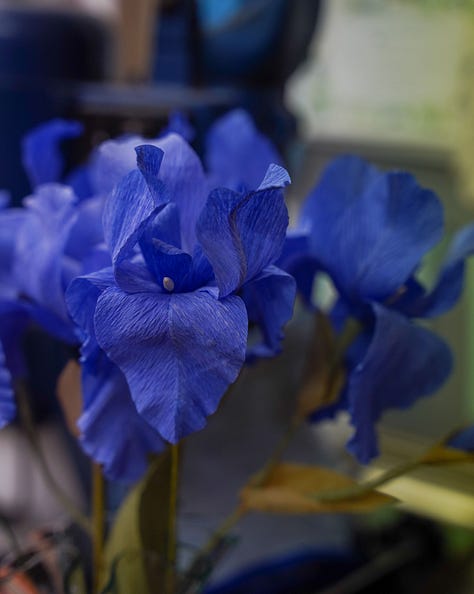
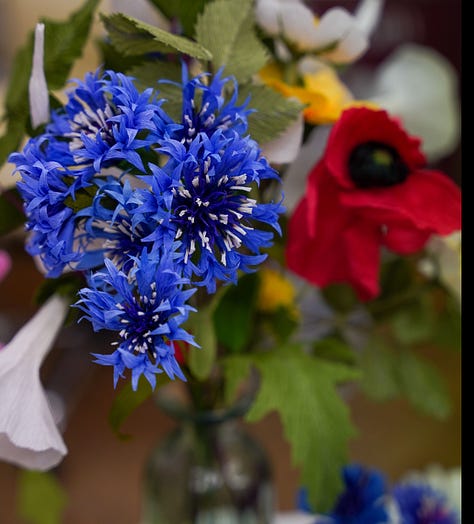

PS IMPORTANT DATES #1: WORKSHOPS IN HOYLAKE: “Blue Paper Iris” (on Tuesday 4th July, 10 - 1) and “Perfect Poppies and Paper Cornflowers” (on Thursday 6th July, 10am - 1pm) are both available at 15% off until 30th June! Both courses take place at Studio 3, 3 Wood Street, Hoylake, CH47 2DU
IMPORTANT DATES #2 There are a few places remaining on the Paper Peony Workshop at Toolerstone, Tarporley, Cheshire. Details and booking here.
PPS Plant blindness: Top picture shows: cowslip, ivy, meadowsweet, ground elder, goosegrass, grass blades, bindweed, bramble, nettle - mostly early growth. Picture three shows nettle cow parsley, hogweed, goosegrass, creeping tormentil, dandelion, marestail and a range of grasses. Please note I’m not a botanist, just an enthusiast and open to being incorrect or having missed something, just tell me!


